Aerobic exercise is one of the most effective ways to improve your heart health, boost energy, and increase longevity. It involves continuous movement that raises your heart rate—like walking, cycling, swimming, or dancing.
Understanding aerobic exercise is important because it directly affects heart function, blood pressure, weight control, energy levels, and long-term disease risk. With just 150–300 minutes per week of moderate movement, you can significantly improve your health and overall fitness.
What Is Aerobic Exercise?
Aerobic exercise (also called “cardio”) involves rhythmic, continuous movement that increases breathing and heart rate for a sustained time. Your body uses oxygen to supply energy during these activities, which strengthens the heart, lungs, and circulatory system.
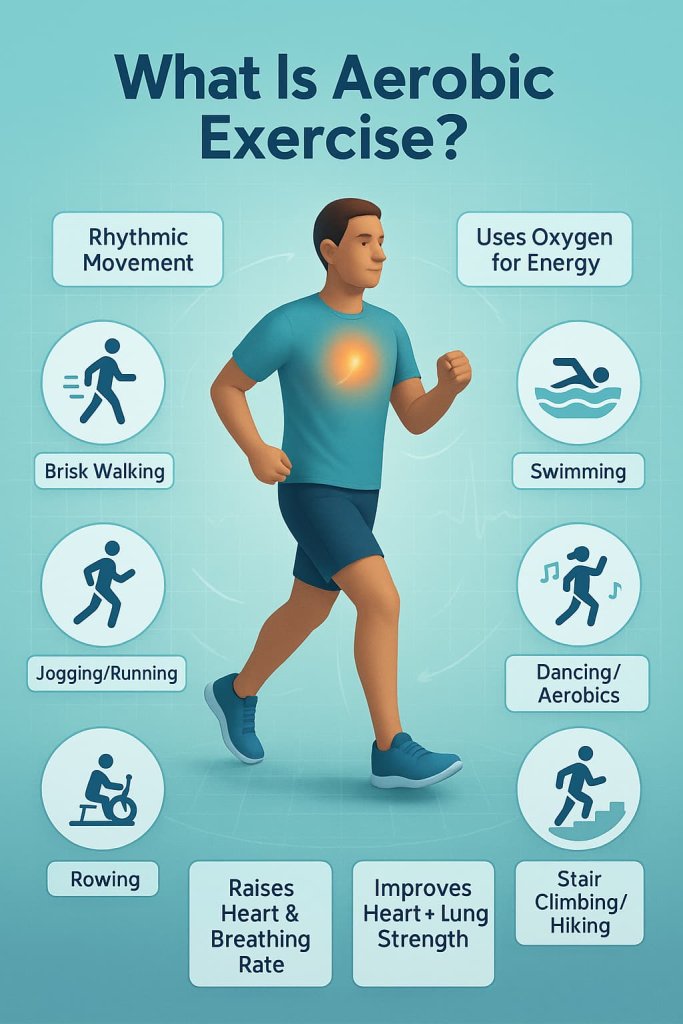
Examples include:
- Brisk walking
- Cycling (indoor or outdoor)
- Swimming
- Jogging or running
- Rowing
- Dancing or aerobics classes
- Stair climbing or hiking
These exercises can be adapted for beginners, seniors, or anyone returning to exercise.
How Much Aerobic Exercise Do You Really Need?
Most adults should follow official guidelines from the World Health Organization (WHO) and the Centers for Disease Control and Prevention (CDC):

Weekly Recommendations
- 150–300 minutes of moderate-intensity aerobic activity, OR
- 75–150 minutes of vigorous-intensity aerobic activity, OR
- A combined equivalent of both intensities
Moderate-intensity means you can talk but not sing, while vigorous intensity means you can speak only a few words at a time.
Strength Training Requirement
Along with aerobic work, adults should also complete muscle-strengthening exercises for all major muscle groups at least 2 days per week.
For Adults 65+
Older adults follow the same weekly minutes but should also add balance and mobility training to reduce fall risk.
Benefits of Aerobic Exercise (Backed by Current Research)
Regular aerobic exercise provides measurable health improvements across cardiovascular, metabolic, respiratory, and mental health systems. Large-scale studies, systematic reviews, and major health organizations consistently show that consistent aerobic movement is one of the most effective ways to improve long-term health outcomes.
Improves Cardiovascular Health

Aerobic exercise directly strengthens the cardiovascular system, improving both heart and blood vessel function.
What the research shows:
- Lowers blood pressure: Regular moderate-intensity aerobic exercise helps reduce systolic and diastolic blood pressure by improving arterial flexibility and reducing vascular resistance. This effect is especially beneficial for individuals with elevated or borderline hypertension. Source: Harvard Health
- Strengthens the heart muscle: Cardio helps the heart pump more efficiently, increasing stroke volume and reducing resting heart rate over time.
Source: American Heart Association - Improves circulation: Aerobic activity enhances blood flow by stimulating capillary growth and improving endothelial function. Source: Cleveland Clinic
- Reduces LDL (“bad”) cholesterol and increases HDL (“good”) cholesterol: Aerobic exercise supports healthier lipid profiles and long-term heart protection.
Source: Mayo Clinic
Why it matters:
Aerobic exercise is widely considered one of the most effective non-medication strategies for maintaining heart health and reducing long-term cardiovascular disease risk.
Helps With Healthy Weight Control
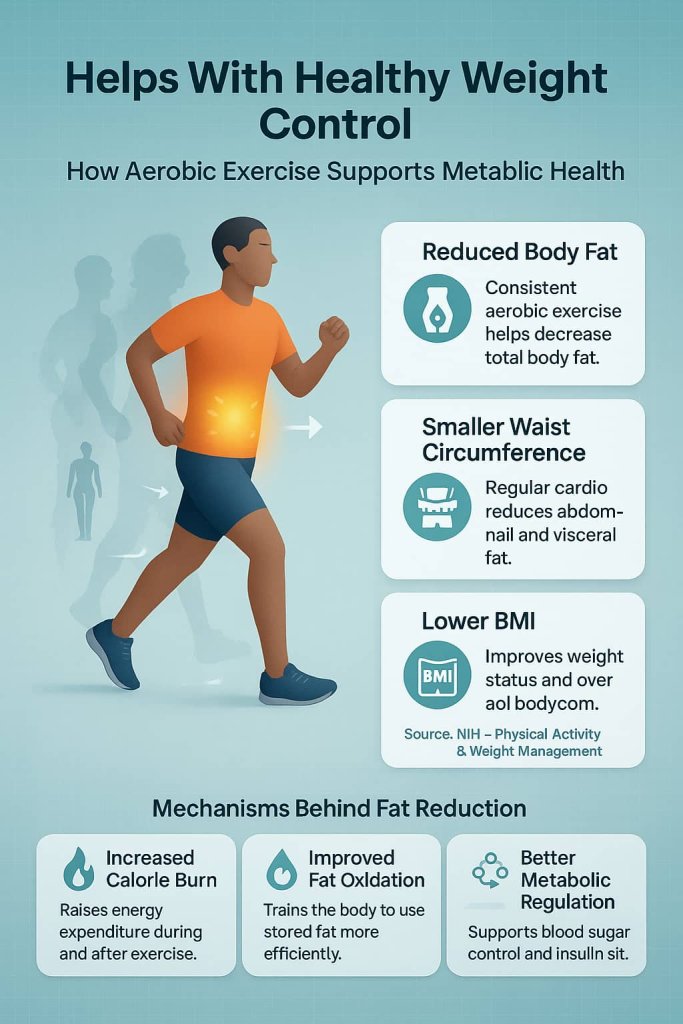
Aerobic exercise plays a central role in weight management and metabolic health.
Evidence from recent studies:
A major 2024 meta-analysis found that individuals performing 150–300 minutes per week of moderate to vigorous aerobic exercise experienced significant reductions in:
- Body fat
- Waist circumference
- Body mass index (BMI)
Source: NIH – Weight Management & Physical Activity
Mechanisms behind fat reduction:
- Increased calorie burn: Movement raises energy expenditure during and after workouts.
- Improved fat oxidation: Cardio trains your body to use stored fat more efficiently.
- Better metabolic regulation: Aerobic exercise improves glucose control and insulin sensitivity.
These effects help decrease abdominal fat, which is closely linked to metabolic disease risks.
Boosts Lung Strength and Endurance
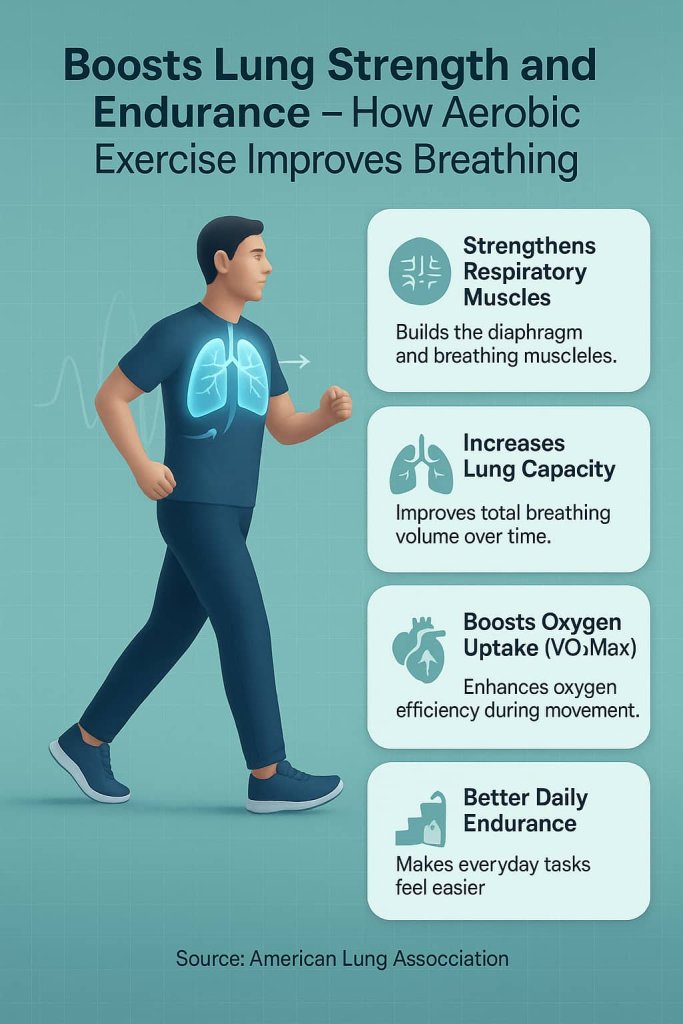
Aerobic exercise improves how efficiently your lungs deliver oxygen to muscles and vital organs.
How it works:
- Strengthens the diaphragm and respiratory muscles
- Increases overall lung capacity
- Improves oxygen uptake (VO₂ max)
- Enhances stamina for daily tasks
Source: American Lung Association
These improvements make everyday movements—like climbing stairs or carrying groceries—feel easier and more comfortable.
Supports Mental Health & Mood

Aerobic exercise has measurable benefits for brain health and emotional well-being.
Key mental health effects supported by research:
- Reduces stress: Cardio boosts endorphin production and helps regulate cortisol.
Source: ADAA Anxiety & Depression Association of America - Improves sleep: Aerobic activity supports healthier circadian rhythms and sleep quality.
Source: Sleep Foundation - Lowers symptoms of anxiety and depression: Cardio positively influences serotonin and dopamine balance.
Source: Mayo Clinic – Exercise & Depression - Enhances cognitive function: Aerobic exercise supports memory, focus, and long-term brain health. Source: CDC – Brain Health & Physical Activity
Even 10–20 minutes of cardio can produce immediate mood improvements.
Lowers Risk of Chronic Diseases

Aerobic exercise is strongly linked to lower risk of several chronic conditions across adulthood.
Research-supported reductions in disease risk:
- Heart disease: Regular aerobic movement is one of the most effective ways to reduce heart disease risk. Source: WHO – Physical Activity Guidelines
- Stroke: Improved circulation and lower blood pressure reduce stroke likelihood.
Source: CDC – Stroke Prevention - Type 2 diabetes: Aerobic exercise helps regulate blood sugar and reduce abdominal fat. Source: CDC – Diabetes Prevention
- Certain cancers: Movement that reduces inflammation and supports metabolic health lowers risk of cancers like breast and colon.
Source: National Cancer Institute - Premature mortality: Meeting weekly aerobic activity guidelines can reduce all-cause mortality by 30–40%, according to large population studies.
Source: CDC – Physical Activity & Health
These protective effects accumulate with time and consistency.
Best Types of Aerobic Exercises
Below are beginner-friendly, joint-friendly, and effective aerobic exercises you can begin right away. Each activity supports cardiovascular fitness, calorie burn, and overall endurance. Choose movements that feel comfortable and enjoyable—consistency matters more than intensity when building long-term habits.
Moderate-Intensity Options
Moderate-intensity aerobic exercises increase your heart rate and breathing but still allow you to talk comfortably. These options are ideal for beginners, older adults, anyone returning to fitness, or people who prefer low-impact movement.
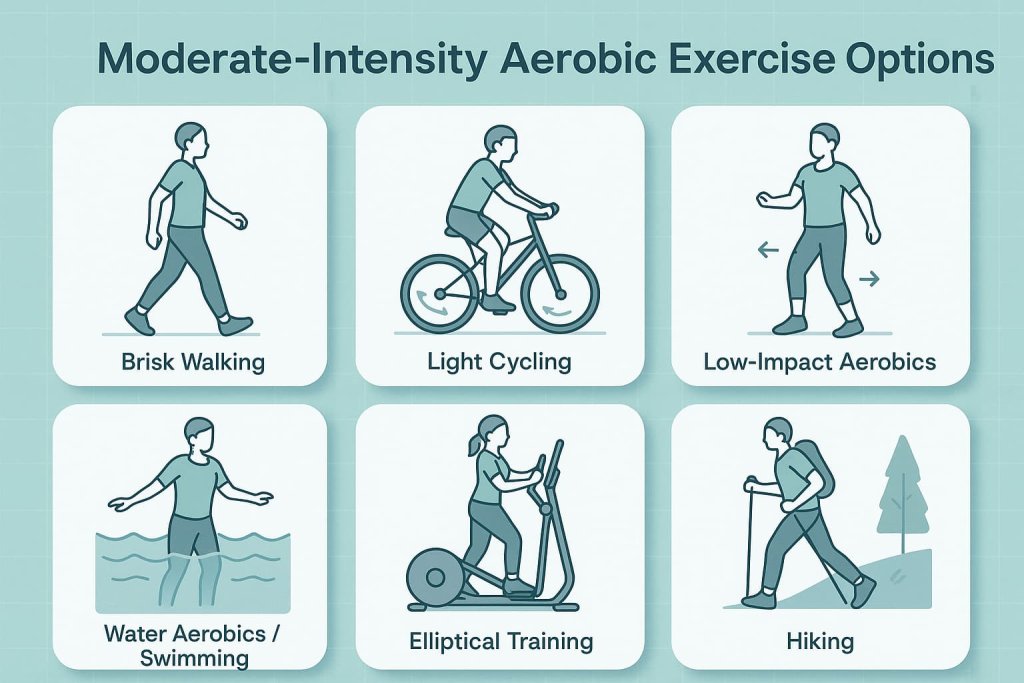
Brisk Walking
One of the safest and most accessible forms of cardio. Walking improves circulation, strengthens the lower body, and supports weight management. Great for all ages and fitness levels.
Light Cycling (Indoor or Outdoor)
A gentle, joint-friendly way to improve cardiovascular endurance. Indoor cycling bikes allow you to control resistance and pace, while outdoor cycling adds fresh air and varied terrain.
Low-Impact Aerobics
These include simple step routines, choreographed movements, or follow-along classes that raise your heart rate without stressing the joints. Perfect for beginners, seniors, or anyone with knee sensitivity.
Water Aerobics or Swimming
Water reduces joint pressure while providing natural resistance, making this ideal for those with arthritis, joint pain, or mobility limitations. Swimming also enhances full-body endurance.
Elliptical Training
Offers a smooth, gliding motion with minimal joint impact. Ellipticals engage both the upper and lower body, making it a balanced option for calorie burning and cardiovascular improvement.
Hiking
Walking on varied terrain increases calorie burn and challenges coordination and leg strength. Gentle nature trails provide a moderate-intensity workout without the strain of steep climbs.
Vigorous-Intensity Options
Vigorous-intensity exercises significantly elevate heart rate and breathing. These workouts are efficient, making them great for those with limited time or looking to boost fitness quickly.
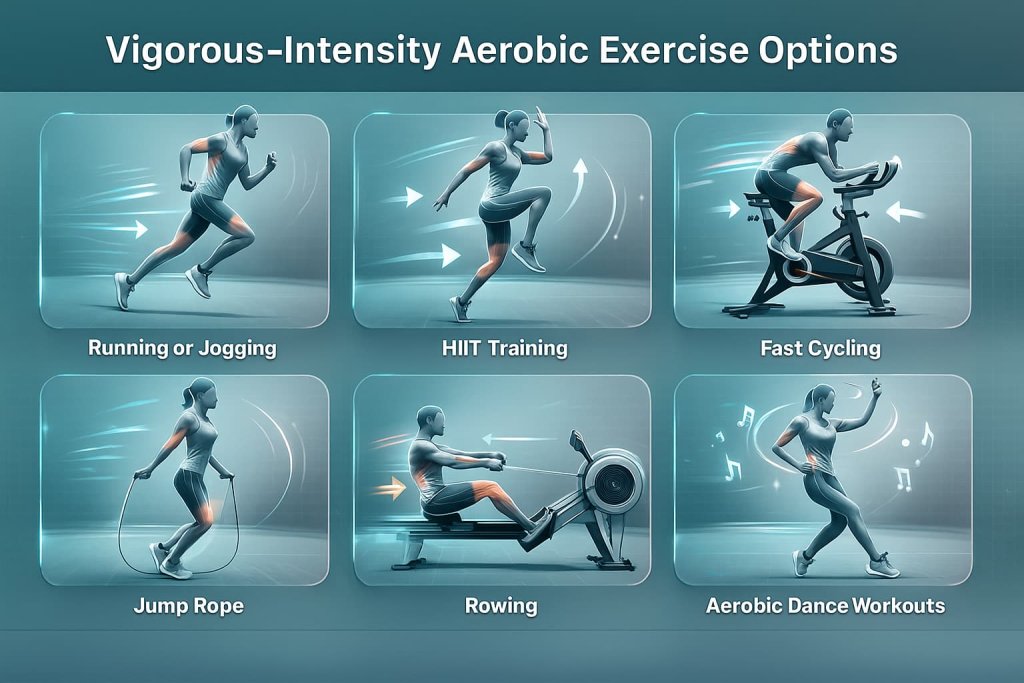
Running or Jogging
A classic, high-efficiency cardio option that strengthens the heart, lungs, and leg muscles. Even short jog intervals (e.g., jog 1 minute, walk 1 minute) offer major endurance benefits.
HIIT (High-Intensity Interval Training)
Short bursts of fast exercise followed by brief rest periods. HIIT workouts burn a high number of calories in a short time and improve both aerobic and anaerobic fitness.
Fast Cycling
Increasing cycling speed or resistance turns a moderate workout into a vigorous one. Fast cycling improves lower-body strength and cardiovascular power.
Jump Rope
A simple but intense exercise that boosts coordination, agility, and cardiovascular health. Just a few minutes can provide a highly effective workout.
Rowing
Rowing machines deliver a full-body workout by engaging the arms, back, core, and legs. It’s low-impact yet high-intensity, making it ideal for people who want efficiency without joint strain.
Aerobic Dance Workouts (Zumba, Cardio Dance, Step Dance)
Energetic movement patterns paired with music increase intensity while keeping the workout fun. Dance cardio burns calories, improves rhythm, and supports stress relief.
How to Start Aerobic Exercise as a Beginner
Starting slowly helps you build strength and avoid injury.
Step-by-step plan
- Begin with 10–15 minutes of light walking or cycling.
- Increase to 20–30 minutes on most days.
- Track your weekly minutes to reach 150–300 total.
- Add a few vigorous sessions if you feel comfortable.
- Include strength training 2 days per week.
Intensity Check (Talk Test)
- Can talk but not sing → Moderate
- Can say only a few words → Vigorous
Safety Tips Before You Begin
- Warm up for 3–5 minutes
- Increase intensity slowly
- Stop if you feel chest pain, dizziness, or unusual shortness of breath
- Wear proper footwear
- Stay hydrated
- If you have heart disease, diabetes, or chronic illness, consult your doctor before starting
Older adults: choose stable, joint-friendly exercises like walking, cycling, or water aerobics.
How to Start Aerobic Exercise as a Beginner
Starting aerobic exercise is simple when you build up gradually. Begin with 10–15 minutes of light movement such as walking or cycling, then add a few minutes each week until you reach 20–30 minutes per session.
Quick Beginner Plan
- Start slow (10–15 minutes, 3–4 days/week)
- Increase time or intensity gradually
- Use the talk test to gauge effort
- Warm up and cool down for 2–5 minutes
- Rotate activities to prevent boredom
- Track progress to stay consistent
Begin with easy options like brisk walking, low-impact aerobics, light cycling, or gentle pool exercises.
Who Should Avoid Certain Aerobic Exercises?
Most people can safely perform aerobic exercise, but some may need to avoid high-impact or high-intensity activities.
Use Caution or Modify If You Have:
- Unstable heart conditions
- Severe joint pain or arthritis flare-ups
- Recent surgery or injury
- Uncontrolled high blood pressure
- Balance or mobility issues
- Respiratory illnesses
Safer Alternatives
Brisk walking, moderate cycling, water aerobics, elliptical training, or low-impact home cardio routines.
These guidelines help ensure your aerobic routine stays safe, effective, and aligned with your current health status.
Common Questions
Is 10 minutes of aerobic exercise enough?
Yes. Research shows short, frequent sessions still provide health benefits—especially for beginners.
Should I do cardio every day?
Daily light aerobic activity (like walking) is safe. Higher-intensity cardio should include rest days.
Does cardio burn belly fat?
Aerobic exercise helps reduce overall body fat, including belly fat, when combined with consistent activity and healthy eating.
Is walking considered aerobic exercise?
Yes—brisk walking is one of the best and safest forms of aerobic exercise for all ages.
What’s the best time of day to do cardio?
Any time works. Choose a time you can stick with consistently.
Conclusion
Aerobic exercise is one of the simplest, most effective habits for improving your health. With just a few sessions a week, you can strengthen your heart, manage your weight, boost mood, and reduce long-term disease risk.
Start small, stay consistent, and choose activities you enjoy. Your heart, body, and mind will thank you.
Ready to begin? Start with a 10-minute brisk walk today and build from there.
